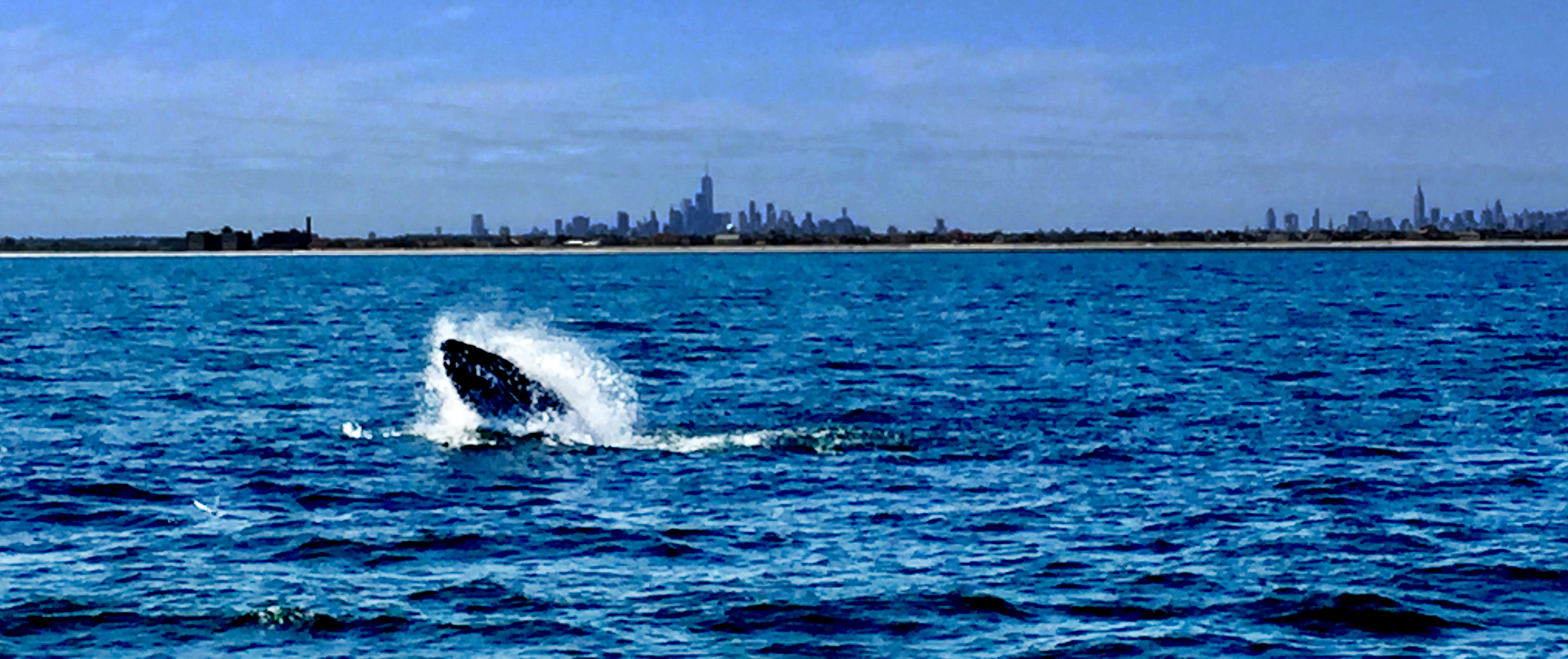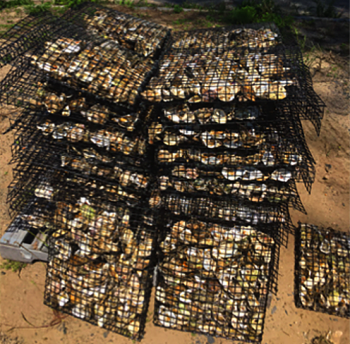Seeing that first sprout of water was unbelievable; seeing the humpback rise out of the water for the first time took my breath away. I was afraid to move or make a sound thinking I’d scare it away.

All photos by Christina Thomas.
New York City is called a “concrete jungle” for good reason – it seems everywhere you look, there’s nothing but sidewalks, roadways, and construction sites putting up new buildings everyday. It’s hard to believe that anything close to nature can exist.
At least, that was my impression before spending two weeks with Pace University’s Nature in the City course, a field trip class that explored all New York City has to offer — and I don’t mean the Empire State Building or Rockefeller Center. Though it took me a while to understand, I now know the true ecological diversity to be found away from the blaring car horns and smelly sidewalk garbage.

Readying the oysters.
Two of our first destinations were the New York Botanical Garden and Governor’s Island. While beautiful locations, I didn’t feel like I was seeing anything new. The Botanical Garden was just another New York City park, where we removed invasive Japanese Knotweed from an off-the-trail forest, our only true interaction with the “wilds” that I see as nature. On our trip to Governor’s Island we visited the Billion Oyster Project and learned about its mission to restore native oysters to New York Harbor. However, the island itself, though isolated from bustling Manhattan, was still tame by my standards of nature and despite being one of my favorite days, everything truly came together for me on our trip to Freshkills during day 3.
When I learn, I find I am more interested when I have a personal connection to the material. Freshkills was the first time during our class when I felt that connection. Near my hometown in Northeastern Pennsylvania, there is a landfill not far from the city of Scranton. It is alarmingly close to residences and a reservoir, and causes problems for people in the area, such as pollution from leachate, water that has percolated through the landfill and become contaminated. That experience connected me with the problems that people on Staten Island faced when Freshkills was still an operating landfill.

Trekking through Freshkills
The smell, aesthetic blight, and the high rates of health problems such as asthma and cancer which we were told about, were all mirrored in the environmental injustice citizens of Scranton, Pennsylvania face. Though no study results have been released to the public, many people in Scranton fear that the higher than normal cancer rates in the area may be partially attributed to the Keystone Sanitary Landfill. What amazed me, however, is how few New Yorkers are aware that Freshkills is no longer the landfill it used to be, but is being turned into a park. It is important that New Yorkers learn that they will soon have a gorgeous public park right in their backyards. It is my hope that Scranton will eventually follow the same plan as New York and transform its landfill into a place that enhances, rather than threatens, people’s lives.
After Freshkills, things really started looking up for me. My quest to find nature in the city took an exciting turn during our Whale Watching trip. When I was a child and aspired to be a marine biologist, I always wanted to see a whale in the wild. Every summer when my grandparents would take me down to Cape May, New Jersey, I would beg them to go out on the whale watching boat in the hopes that something would show. However, we never got lucky and only saw dolphins — which were incredible but a common sight down by the shore.
I kept my eyes fixed on the water, watching for every little sign a whale was about to breach.
Though the class whale watching day started out rocky (getting up 6:30 AM on a Sunday morning was new for me and something I do not wish to do again any time soon), it culminated in the most incredible experience of my life. Though I had to embrace my inner surfer, balancing myself on the boat deck to keep from going overboard, every minute was worth it. Our eyes were not yet trained about what to look for in the water, but Catherine, our guide, made sure to answer all our questions and keep us in the loop about what was going on throughout the trip.
I kept my eyes fixed on the water, watching for every little sign that would tell me a whale was about to breach. Seeing that first sprout of water was unbelievable; seeing the humpback rise out of the water for the first time took my breath away. I was afraid to move or make a sound thinking I’d scare it away (which I know is ridiculous but, like I said, I was fulfilling a lifelong dream). The realization that a giant creature that lives in the water was literally right next to us made me understand that something about marine life still haunts me, making the experience all the more fascinating.
It was surreal to see the New York City skyline in the background each time the whale fed. It made me think that while a few miles across the water, people were enjoying another typical New York City Sunday, I was not far off experiencing something that many New Yorkers don’t even realize exists in their backyard. When I went home that night and described the day to my host, she was amazed that such an event can be experienced just a short drive away from her house in Brooklyn. While sitting out on a boat all day just hoping to see a whale may not be exciting to some people, I truly believe it’s something that needs to be experienced at least once, especially if your backyard is a whale’s ideal habitat for half the year.

Gowanus Canal
Of all the days during our two weeks of class, however, my favorite was our trip to the Gowanus Canal. This was the day that brought it all together for me — the day I truly realized there was nature in New York City.
As I mentioned before, a vested interest in the material helps me connect with the subject. Since I live in downtown Manhattan for most of the year, Brooklyn seems like a backyard to me. Yet, I’ve walked the area many times without realizing the canal was there or knowing about the gentrification that is taking place. The canal used to be used as a dumping ground for many factories that were located in the area. Years of pollution have lead to the canal being designated a superfund site by the EPA and clean up operations are ongoing and may take many years. Learning the canal’s history, having the opportunity to walk alongside it all day, and having Professor Finewood point out features of note brought all the goals of the class together. For the first time, I felt like I was actually seeing nature interact with the city itself. Though the parks and wildlife refuges we visited were amazing, they were too distant for me to consider them in the city. They seemed more like their own places in and of themselves.
The Gowanus Canal was something different for me. It was nature manipulated by people, yet still trying to grow and reclaim what it once was. Though a lot of cleanup will have to go into restoring the waterway, life is still present there in the form of bacteria, fish, and birds that could be seen swimming and diving into the water.
While the Gowanus may never be as clean as it used to be, seeing the efforts people are making now to try and minimize their impact on the waterway is inspiring. While I tend to think of New York City as a place people like to go and live to escape from the silence, idleness, and bugs of the “country,” there are still people doing great work to try and protect the city’s nature, such as the Gowanus Canal Conservancy, that give me a new view on nature in the city and all it has to offer.
Though my definition of nature is still inspired by the forests and rolling hills of Pennsylvania, every state and ecosystem is different and just because the city is a concrete jungle doesn’t mean nature can’t thrive in places where it’s given a chance. If this class has taught me anything, it’s that nature can be seen everywhere. If I had to summarize it in one sentence, it would be the following: nature will always continue to grow, thrive, and make its own path despite human attempts to control it.
In time, I hope we can all find a way to work alongside nature, in all its forms. After all, since nature will always fight to reclaim what it once was, we should commit ourselves to protecting and preserving what we already have so we can continue to experience it, no matter where we live.
